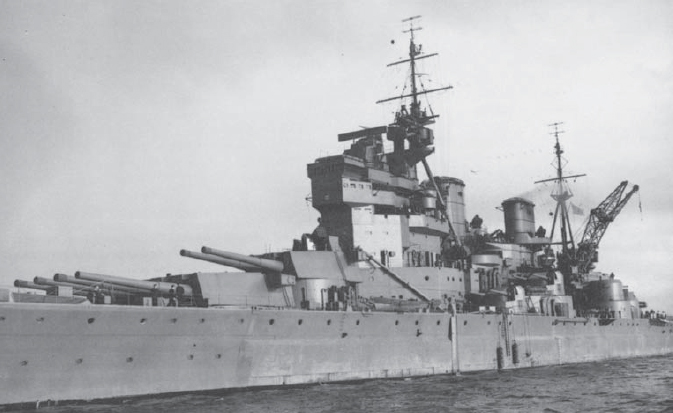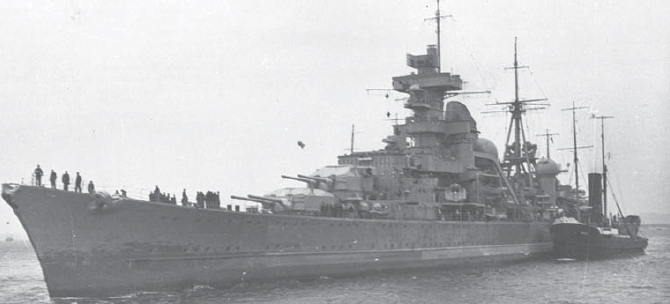
The survivors told their rescuers a harrowing tale. They escaped from a floating hell, where dead seamen or horrifically injured and dying young men lay everywhere. The passageways and decks were covered in blood and gore, and those who made it out had to fight their way past their shipmates who were too badly injured to escape. Many were trapped below decks by hatches that couldn’t be opened thanks to shell damage, and the cries of the wounded and dying were heart-rending. Those who made it out onto the upper deck encountered a similar scene, with the added hazard of fires raging out of control.
One of these survivors was Kapitänleutnant von Müllenheim-Rechberg, the only officer to escape from the sinking ship. When his gunnery equipment was wrecked, and the guns silenced, he made his way down to the deck, where he saw just how bad the damage really was. ‘Everything up to the bridge bulwarks had been destroyed. The hatches leading to the main deck were jammed shut… flames cut off the whole forward part of the ship. Hundreds of crewmen lay where they had been hit, in the foretop, on the bridge, in the control stations, at the guns, on the upper deck, and on the main and battery decks.’ He eventually reached the quarterdeck, where he was able to jump into the sea and swim away from the sinking ship.
Another survivor told how the dead and wounded littered the upper deck, and when the ship began to list many of these men were washed into the sea, where the waves often threw them back against the side of the ship. Others also told of hundreds of men trapped inside the ship by jammed hatches, while others sat around, as if resigned to their fate. Sailors were driven mad, while others took their own lives. All the while more shells were striking the ship, ripping holes in the superstructure or decks, and causing even more chaos, death and horror. Those that made it through the floating hell to the quarterdeck slipped into the water, and tried to escape.
The airmen on a Swordfish from Ark Royal flying over the scene described how hundreds of bodies – alive and dead – bobbed around in the water as the ship finally went under. Those were the men who swam towards the Dorsetshire, hoping that the worst was behind them. Instead, hundreds were unavoidably left to their fate, as the cruiser was forced to steam away.
On King George V, Vice Admiral Tovey witnessed the dying minutes of the Bismarck, and he later paid a moving testimony to her men. ‘The Bismarck had put up a most gallant fight against impossible odds, worthy of the old days of the Imperial German Navy, and she went down with her colours flying.’ It was a spectacular and Wagnerian end to a worthy foe.

Oil-coated survivors from the Bismarck are hauled to safety on board the cruiser Dorsetshire, which was the closest British vessel to the battleship when she sank. Tragically the rescue soon had to be abandoned, leaving the majority in the water.

HMS Prince of Wales, photographed at Scapa Flow before her encounter with the Bismarck in the Denmark Strait. Her new paint betrays the fact that she was fresh from the shipyard, and she was still plagued by mechanical ‘teething troubles’.
Of course, the campaign didn’t end suddenly with the sinking of the Bismarck. Like any naval campaign, there were loose ends. One of these was the Prinz Eugen, which parted company with the Bismarck on the evening of 24 May. She steamed south towards the main transatlantic convoy routes, and away from the British warships searching for the Bismarck. Two days later she rendezvoused with the German tanker Spichern, and refuelled in mid-Atlantic. Kapitän Brinkmann still planned to hunt for British convoys, but he spent three fruitless days searching for them. In fact, the Admiralty had diverted them away from the area, fearing they might inadvertently run into either the Bismarck or her former consort.
Then, on 29 May, a fault developed with her engines, and Brinkmann decided to head back to port, and turned towards the French coast. That was two days after the sinking of the Bismarck, and the Home Fleet had already returned to Scapa Flow or other British ports. This meant that the Western Approaches were relatively free of British warships, and the Prinz Eugen finally reached the safety of Brest on 1 June. Less fortunate were the German tankers and supply ships, scattered throughout the Atlantic to support the Bismarck. They were all located and destroyed in the weeks that followed.
In February 1942 the Prinz Eugen slipped out of port in company with the battlecruisers Scharnhorst and Gneisenau, and headed through the English Channel to reach the safety of German and Norwegian ports. The ‘Channel Dash’ was a daring and successful enterprise, but it revealed that the Kriegsmarine were no longer interested in using their vulnerable surface ships to attack the Atlantic convoys. After the loss of the Bismarck, the Seekriegsleitung was extremely unwilling to risk their remaining capital ships in what they saw as a suicidal venture.
As for the British ships that took part in the pursuit of the Bismarck, several would succumb to enemy action before the end of the war. The Tribal-class destroyer Mashona was sunk by prowling German bombers the day after the Bismarck, as she headed home through the Western Approaches. On 13 November the Ark Royal was torpedoed by a German U-boat as she returned to her base at Gibraltar after a foray into the Mediterranean. The Prince of Wales was repaired after the damage she suffered at the hands of the Bismarck, and she was then sent to the Far East. On 10 December 1941 Japanese aircraft off the coast of Malaya sank her and the battlecruiser Repulse. However significant these British losses might have been, they never altered the naval balance in favour of the Axis powers, while the loss of the Bismarck had a significant impact on German naval power, and an equally dramatic influence on the Kriegsmarine’s belief in its own abilities.

The heavy cruiser Prinz Eugen, photographed after her safe arrival in Brest on 1 June 1941. Kapitän Brinkmann managed to evade the British, and had sailed 7,000 miles (13,000km) since leaving Gotenhafen two weeks earlier, thereby bringing Operation Rheinübung to a close.
Of course, both sides could argue that they made mistakes during the campaign. If the Bismarck had refuelled in Norway it might have been able to reach Brest at full speed, even after suffering damage during the battle of the Denmark Strait. During the battle, Holland might have handled his ships better, and reduced the risk to his vulnerable flagship. Similarly, if Lütjens had not been constrained by orders, he might have been able to finish off the Prince of Wales, rather than break off the action. Then there was Lütjens’ signal, which told the British roughly where to look. If any of these mistakes had been avoided, Operation Rheinübung might have ended very differently.
The ‘what if’ aspects of the campaign are certainly fascinating, especially as the Bismarck came so close to evading her pursuers. As Winston Churchill put it: ‘Had she escaped, the moral effects of her continuing existence, as much as the material damage she might have inflicted on our shipping, would have been calamitous. Many misgivings would have arisen regarding our capacity to control the oceans, and these would have been trumpeted around the world, to our great detriment and discomfort.’ Fortunately for Great Britain, the sortie proved a disaster for the Kriegsmarine, and the Royal Navy remained the unchallenged arbiters of seapower. As Großadmiral Raeder admitted; ‘The loss of the Bismarck had a decisive effect on the conduct of the war at sea.’ With hindsight, it is easy to assume that the Bismarck was doomed from the moment she set sail. During that long tense week in May 1941, the situation was a lot less clear cut.